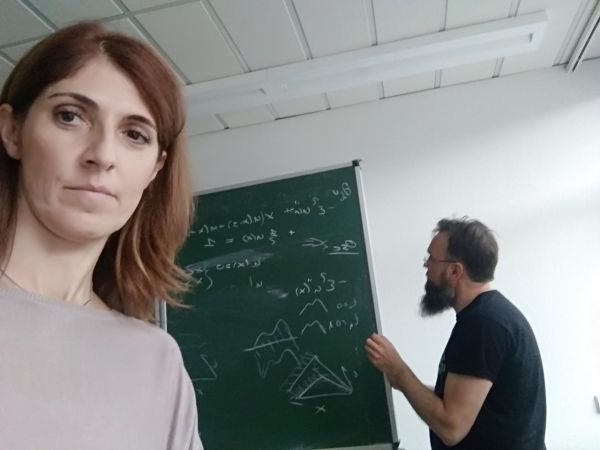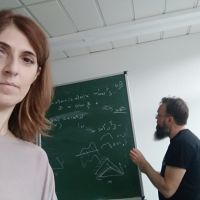Singularly perturbed problems with multiple parameters
Title of the project:
Singularly perturbed problems with multiple parameters
Project number:
-
Funding sources:
Ministry of Education, Science and Technological Development of the Republic of Serbia
Duration of the project:
2021 – 2022.
Project budget:
4.000,00 eur / per year
Logo or acronym:
-
Research area of the project:
Mathematics
Principal investigator:
Dr. Mirjana Brdar, assistant professor, Faculty of Technology Novi Sad, University of Novi Sad
Reseach team:
Dr. Ljiljana Teofanov, full professor, Faculty of Technical Sciences, University of Novi Sad
Dr. Goran Radojev, assistant professor, Faculty of Sciences, University of Novi Sad
Dr. Davor Kumozec, assistant, Faculty of Sciences, University of Novi Sad
Key words:
singularly perturbed problem, layer-adapted mesh, finite element method, reaction-convection-diffusion problem
Project summary:
First, we will focus our attention on second order linear SPP with two small parameters. One example is a convection-diffusion-reaction problem posed on the unite square. This problem has two small parameters and is characterized by exponential and parabolic boundary layers, and corner layers at the four corners of the domain, where the solution changes rapidly. These layers, especially parabolic boundary layers, impose difficulties in the construction of appropriate numerical methods. Parabolic layers are thicker than regular layers but due to their parabolic nature, the related approximation process have to be taken with a special care. The general strategy in the construction of any numerical method for SPP is to apply some finite difference or finite element method (FEM) on a specially designed layer-adapted mesh or together with a stabilization method. This is illustrated in the second edition of the monograph by Roos, Stynes and Tobiska, “Robust Numerical Methods for Singularly Perturbed Differential Equations”, Springer-Verlag, Berlin 2008. FEM is one of the most frequently used techniques for the approximation of the solution of partial differential equations, and streamline-diffusion FEM (SDFEM) is one of the most popular stabilized FEM. Compared with the standard Galerkin FEM, the SDFEM adds weighted residuals to the Galerkin FEM and provides additional control over the convective derivative in the streamline direction. This additional bound prevents the discrete solution from oscillating over a large part of the domain. Another alternative to stabilization is the discontinuous Galerkin method (DGM) which appears suitable for the numerical solution of problems with solutions containing steep gradients. We will focus on these and other stabilization methods. However, in layer regions the SDFEM fails to compute accurate solutions unless layer adapted meshes are used. Of the many layer-adaptive meshes it is very interesting Duran-Lombardi (DL) mesh, introduced in (R. G. Duran, A. Lombardi, Finite Element Approximation of Convection Diffusion Problems using Graded Meshes, Applied Numerical Mathematics, 56 (2006) 1314-1325), an alternative to Shishkin and Shishkin-like S-type meshes. Unlike S-meshes, it doesn’t have transition point(s), has good performances even when perturbation parameter(s) is close to 1, and it seems that for the analysis of a method on DL mesh the solution decomposition is not always needed. In addition to the DL mesh, we will also use other layer-adaptive mesh to make comparisons, and further develop numerical methods. When studying the SDFEM for SPP, the main question is the choice of stabilization parameters on problem subdomains. The optimal choice of stabilization parameter of the SDFEM for problems with characteristic layers is still an open problem. We emphasize that the stabilization in two-parameter problems is quite different from the stabilization for one-parameter problems. That is because in the two-parameter case, stabilization is very sensitive to the relation between the two perturbation parameters ε1 and ε2, and the number of mesh intervals N used for the discretization. We will investigate the possibilities of finding the optimal stabilization parameter with giving a special attention to the second parameter influence on that choice. In 2018 a family of Galerkin finite element methods which are constructed via recovery operators over element wise discontinuous approximation spaces was introduced in (E. H. Georgoulis and T. Pryer, Recovered Finite Element Methods, Computer Methods in Applied Mechanics and Engineering 332 (2018) 303–324). This new family, termed collectively as recovered finite element methods (R-FEM) has a number of attractive features over both classical finite element and discontinuous Galerkin approaches, most important of which is its potential to produce stable conforming approximations in a variety of settings. They show numerical results for convection-diffusion problem on non-adapted meshes and they look promising. No analysis for our problem using recovered finite elements is given so far, but we are confident that on adapted meshes the analysis should be possible, giving new insights to the choice of discretisation spaces and their corresponding convergence.
Our objective 1 is: • to research stabilization for 2nd order problems, giving special attention to standard stabilization like SDFEM or DGM on graded meshes like DL- or S-type meshes, • to confirm theoretical results by numerical results, • to compare the results on various meshes, • to investigate the possibilities of finding optimal stabilization parameters with giving a special attention to the second parameter influence on that choice, • to apply recovered finite elements. Systems of ordinary differential equations are often discussed in books on asymptotic expansions for singularly perturbed problems (see A. B. Vassiljewa, W. F. Butusov, Asymptotic expansions in the theory of singular perturbations (in Russian), Higher School, Moscow, 1990 and W. Wasow. Asymptotic expansions for ordinary differential equations, John Wiley, New York, 1965). Nevertheless, in the past relatively little attention was paid to their numerical solution, although the paper (A. S. Bakhvalov, On the optimization of methods for solving boundary value problems with boundary layers (in Russian), Zh. Vychisl. Mat. i Mat. Fis., 9 (1969) 841-859) on reaction-diffusion systems and (L. R. Abrahamsson, H. B. Keller, H. O. Kreiss, Difference approximations for singular perturbations of systems of ordinary differential equations, Numer. Math., 22 (1974) 367-391), on convection-diffusion systems are worth noting. In recent years interest in this area has grown. We are also interested in first order reaction-diffusion systems. As far as we know, this kind of problem are not analyzed yet. Analyzing this and extending it to convection-diffusion systems would be also interesting.
Our objective 2 is: • to numerical analyze and solve first order reaction-diffusion system, • to numerical analyze and solve first order convection-diffusion system, • to investigate stabilization methods for this application. It is one aim of the project to combine the know-how of the two research groups. The research group in Novi Sad has certain experience in studying two-parameter SPP while the group in Dresden has extensive experience in analyzing one-parameter singularly perturbed problems and simulating them numerically. Mutual exchange of knowledge and experiences will contribute to a faster and more successful solution of the set problems. The experienced participants will monitor the scientific work and help in modeling, analysis and computation. Study visits and exchange of personnel will produce more rapid flow of information, open some up-to-date research subjects and put the level of research standards (specially for young researchers) higher than the local ones. As communication is extremely important part of scientific work, the possibilities for results of highest quality will be increased.
Our objective 3 is: • to enhance research skills, build capacities, and improve innovation performance and scientific output of the Serbian-Germany team, • to exchange knowledge and network at international level, increase the scientific visibility of the team by doing research which is globally relevant and competitive.












